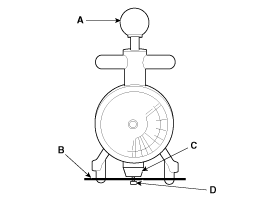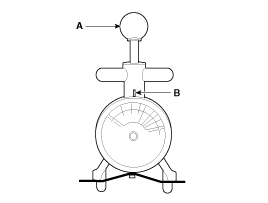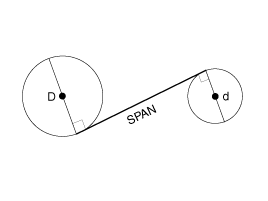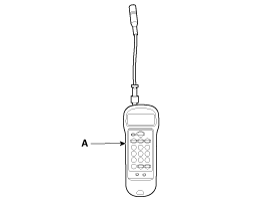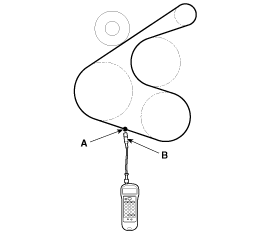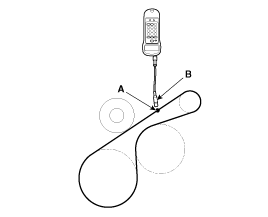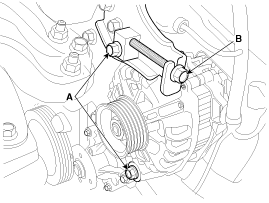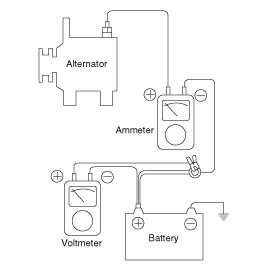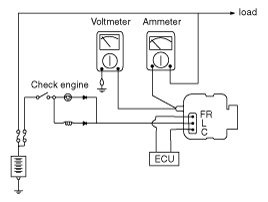 Hyundai Veloster: Repair procedures
Hyundai Veloster 2011-2017 Service Manual / Engine Electrical System / Charging System / Repair procedures
Hyundai Veloster: Repair procedures
Hyundai Veloster 2011-2017 Service Manual / Engine Electrical System / Charging System / Repair procedures
On-vehicle Inspection
|
Check Battery Voltage
| 1. |
If 20 minutes have not passed since the engine was stopped, turn
the ignition switch ON and turn on the electrical system (headlamp,
blower motor, rear defogger etc.) for 60 seconds to remove the surface
charge.
|
| 2. |
Turn the ignition switch OFF and turn off the electrical systems.
|
| 3. |
Measure the battery voltage between the negative (-) and positive
(+) terminals of the battery.
If the voltage is less than specification, charge the battery.
|
Check The Battery Terminals And Fuses
| 1. |
Check that the battery terminals are not loose or corroded.
|
| 2. |
Check the fuses for continuity.
|
Inspect Drive Belt
Cracks on the rib side of a belt are considered acceptable. If
the belt has chunks missing from the ribs, it should be replaced.
|
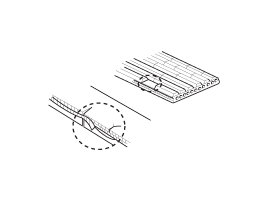
Drive belt tension measurement and adjustment
| Belt tension measurement |
Tension
New belt: 882.6 ~ 980.7N (90 ~ 100kg, 198.4 ~ 220.5lb)
Used belt: 637.4 ~ 735.5N (65 ~ 75kg, 143.3 ~ 165.3lb)
|
|
| Using a mechanical tension gauge (BT-33-73F, BTG-2 type) |
| 1. |
While pressing the handle (A) of the gauge, insert the belt (B)
between pulley and pulley (or idler) into the gap between spindle (C)
and hook (D).
|
| 2. |
After releasing the handle (A), read a value on the dial pointed
by the indicator (B).
|
| Using a sonic tension meter (U-505/507 type) |
| 1. |
Input the belt specifications into the tension meter.
|
|||||||||||||||||||||
| 2. |
Locate the micro phone (B) close to the center of belt span (A)
and bounce the belt by finger 2~3 times. Read a value on the display.
[With A/C]
[Without A/C]
|
| If adjustment is necessary: |
| 1. |
Loosen the mounting bolts (A).
|
| 2. |
Tighten the adjusting bolt(B) clockwise in loose tension ; loosen
the bolt counterclockwise in high tension.
|
| 3. |
Recheck tension of the belt.
|
| 4. |
After adjusting tension, tighten the through bolts.
|
Visually Check Alternator Wiring And Listen For Abnormal Noises
| 1. |
Check that the wiring is in good condition.
|
| 2. |
Check that there is no abnormal noise from the alternator while
the engine is running.
|
Check Discharge Warning Light Circuit
| 1. |
Warm up the engine and then turn it off.
|
| 2. |
Turn off all accessories.
|
| 3. |
Turn the ignition switch "ON". Check that the discharge warning
light is lit.
|
| 4. |
Start the engine. Check that the light is lit.
If the light does not go off as specified, troubleshoot the discharge
light circuit.
|
Voltage Drop Test Of Alternator Output Wire
Preparation
| 1. |
Turn the ignition switch to "OFF".
|
| 2. |
Disconnect the output wire from the alternator "B" terminal. Connect
the (+) lead wire of ammeter to the "B" terminal of alternator and the
(-) lead wire of ammeter to the output wire. Connect the (+) lead wire
of voltmeter to the "B" terminal of alternator and the (-) lead wire
of voltmeter to the (+) terminal of battery.
|
Test
| 1. |
Start the engine.
|
| 2. |
Turn on the headlamps and blower motor, and set the engine speed
until the ammeter indicates 20A.
And then, read the voltmeter at this time.
|
Result
| 1. |
The voltmeter may indicate the standard value.
|
| 2. |
If the value of the voltmeter is higher than expected (above 0.2V
max.), poor wiring is suspected. In this case check the wiring from
the alternator "B" terminal to the battery (+) terminal. Check for loose
connections, color change due to an over-heated harness, etc. Correct
them before testing again.
|
| 3. |
Upon completion of the test, set the engine speed at idle.
Turn off the headlamps, blower motor and the ignition switch.
|
Output Current Test
Preparation
| 1. |
Prior to the test, check the following items and correct as necessary.
Check the battery installed in the vehicle to ensure that it is
in good condition. The battery checking method is described in the section
"Battery".
The battery that is used to test the output current should be
one that has been partially discharged. With a fully charged battery,
the test may not be conducted correctly.
Check the tension of the alternator drive belt. The belt tension
check method is described in the section "Inspect drive belt".
|
| 2. |
Turn off the ignition switch.
|
| 3. |
Disconnect the battery ground cable.
|
| 4. |
Disconnect the alternator output wire from the alternator "B"
terminal.
|
| 5. |
Connect a DC ammeter (0 to 150A) in series between the "B" terminal
and the disconnected output wire. Be sure to connect the (-) lead wire
of the ammeter to the disconnected output wire.
|
| 6. |
Connect a voltmeter (0 to 20V) between the "B" terminal and ground.
Connect the (+) lead wire to the alternator "B" terminal and (-) lead
wire to a good ground.
|
| 7. |
Attach an engine tachometer and connect the battery ground cable.
|
| 8. |
Leave the engine hood open.
|
Test
| 1. |
Check to see that the voltmeter reads as the same value as the
battery voltage. If the voltmeter reads 0V, and the open circuit in
the wire between alternator "B" terminal and battery (+) terminal or
poor grounding is suspected.
|
| 2. |
Start the engine and turn on the headlamps.
|
| 3. |
Set the headlamps to high beam and the heater blower switch to
HIGH, quickly increase the engine speed to 2,500 rpm and read the maximum
output current value indicated by the ammeter.
|
Result
| 1. |
The ammeter reading must be higher than the limit value. If it
is lower but the alternator output wire is in good condition, remove
the alternator from the vehicle and test it.
|
| 2. |
Upon completion of the output current test, lower the engine speed
to idle and turn off the ignition switch.
|
| 3. |
Disconnect the battery ground cable.
|
| 4. |
Remove the ammeter and voltmeter and the engine tachometer.
|
| 5. |
Connect the alternator output wire to the alternator "B" terminal.
|
| 6. |
Connect the battery ground cable.
|
Regulated Voltage Test
Preparation
| 1. |
Prior to the test, check the following items and correct if necessary.
Check that the battery installed on the vehicle is fully charged.
The battery checking method is described in the section "Battery".
Check the alternator drive belt tension. The belt tension check
method is described in the section "Inspect drive belt".
|
| 2. |
Turn ignition switch to "OFF".
|
| 3. |
Disconnect the battery ground cable.
|
| 4. |
Connect a digital voltmeter between the "B" terminal of the alternator
and ground. Connect the (+) lead of the voltmeter to the "B" terminal
of the alternator. Connect the (-) lead to good ground or the battery
(-) terminal.
|
| 5. |
Disconnect the alternator output wire from the alternator "B"
terminal.
|
| 6. |
Connect a DC ammeter (0 to 150A) in series between the "B" terminal
and the disconnected output wire.
Connect the (-) lead wire of the ammeter to the disconnected output
wire.
|
| 7. |
Attach the engine tachometer and connect the battery ground cable.
|
Test
| 1. |
Turn on the ignition switch and check to see that the voltmeter
indicates the following value.
If it reads 0V, there is an open circuit in the wire between the
alternator "B" terminal and the battery and the battery (-) terminal.
|
| 2. |
Start the engine. Keep all lights and accessories off.
|
| 3. |
Run the engine at a speed of about 2,500 rpm and read the voltmeter
when the alternator output current drops to 10A or less
|
Result
| 1. |
If the voltmeter reading dosen't agree with the standard value,
the voltage requlator or the alternator is faulty.
|
| 2. |
Upon completion of the test, reduce the engine speed to idle,
and turn off the ignition switch.
|
| 3. |
Disconnect the battery ground cable.
|
| 4. |
Remove the voltmeter and ammeter and the engine tachometer.
|
| 5. |
Connect the alternator output wire to the alternator "B" terminal.
|
| 6. |
Connect the battery ground cable.
|
 Description and Operation
Description and Operation
Description
The charging system includes a battery, an alternator with a built-in
regulator, and the charging indicator light and wire.
The Alternator has built-in diodes, each rectifying A ...
 Alternator
Alternator
...
See also:
Variable Intake Solenoid (VIS) Valve. Schematic Diagrams
Circuit Diagram
...
Description and Operation
Limitations Of The Navigation system
GPS Signal Reception State
As the GPS satellite frequency is received/transmitted in straight lines,
reception may not work if hiding devices are placed ...
Fuel Tank Pressure Sensor (FTPS). Repair procedures
Inspection
1.
Connect the GDS on the Data Link Connector (DLC).
2.
Measure the output voltage of the FTPS.
Specifica ...
Categories
- Hyundai Veloster Manuals Home
- Hyundai Veloster 2010-2017 Owner's Manual
- Hyundai Veloster 2010-2017 Service Manual

